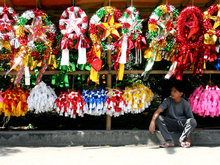
A parol (pronounced [paˈɾol], US: /pɑːˈroʊl/ , also written as paról or parul, from Spanish farol, meaning lantern) is a Filipino ornamental lantern displayed during the Christmas season. Parols are traditionally constructed using bamboo and Japanese paper, and are illuminated with candles, oil lamps, or carbide lamps. Modern parols can be made using other materials such as plastic, metal, and capiz shells and are usually illuminated with electric lighting. Its most-common form is a five-pointed star, although it can come in various shapes and sizes.[1][2][3] Large disc-shaped electronic versions of parols produced in Pampanga are known as "parul sampernandu",[4] the phonetic spelling of parol San Fernando, owing to the city where these lanterns are a major product.
The parol is a traditional part of the Panunulúyan pageant in the nine-day Christmas Novena procession during the Spanish colonial period of the Philippines. It was initially rectangular or oblong in shape and was made with white paper, but eventually came to be made in various shapes and colors. It became standardized to a five-pointed star (symbolizing the Star of Bethlehem) during the American colonial period.[5] It remains an iconic symbol of Filipino Christmas.
- ^ J., John (2005). A Christmas Compendium. Continuum International Publishing Group. p. 67. ISBN 0-8264-8749-1. Retrieved December 20, 2007.
- ^ Magocsi, Paul R. (2006). Encyclopedia of Canada's Peoples. University of Toronto Press (published 1999). p. 510. ISBN 0-8020-2938-8. Retrieved December 20, 2007.
- ^ "Christmas decors, Filipino-style" (in Tagalog). GMA news.TV. December 10, 2007. Retrieved December 20, 2007.
- ^ Cite error: The named reference
Pangilinanwas invoked but never defined (see the help page). - ^ Cite error: The named reference
Tanwas invoked but never defined (see the help page).